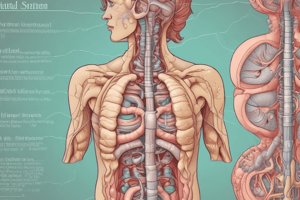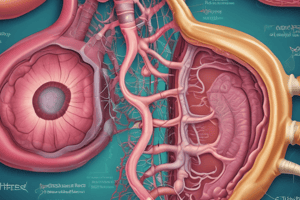Podcast
Questions and Answers
Which of the following physiological processes is directly disrupted in the pathophysiology of gastritis?
Which of the following physiological processes is directly disrupted in the pathophysiology of gastritis?
- The production of intrinsic factor for vitamin B12 absorption.
- The secretion of bile acids into the duodenum.
- The peristaltic movement of the small intestine.
- The integrity of the gastric mucosal barrier. (correct)
A patient with a history of chronic NSAID use is diagnosed with gastritis. Which mechanism is most likely contributing to the development of gastritis in this patient?
A patient with a history of chronic NSAID use is diagnosed with gastritis. Which mechanism is most likely contributing to the development of gastritis in this patient?
- Increased production of protective prostaglandins in the stomach lining.
- Direct toxic effect of NSAIDs on the liver, leading to altered bile production.
- Stimulation of gastric acid secretion by NSAIDs.
- Inhibition of prostaglandin synthesis, leading to decreased gastric mucosal protection. (correct)
A patient presents with epigastric pain, dyspepsia and nausea. The patient reports regular alcohol use. Which condition is most likely responsible for these symptoms?
A patient presents with epigastric pain, dyspepsia and nausea. The patient reports regular alcohol use. Which condition is most likely responsible for these symptoms?
- Celiac Disease
- Gastritis (correct)
- Ulcerative Colitis
- Achalasia
A patient is diagnosed with gastritis following a severe burn injury. What is the most likely mechanism contributing to the development of gastritis in this scenario?
A patient is diagnosed with gastritis following a severe burn injury. What is the most likely mechanism contributing to the development of gastritis in this scenario?
A patient with gastritis is prescribed a medication to reduce gastric acid secretion. Which type of medication is most likely prescribed?
A patient with gastritis is prescribed a medication to reduce gastric acid secretion. Which type of medication is most likely prescribed?
A patient who underwent an esophagogastroduodenoscopy (EGD) was found to have erosion of the gastric mucosa. Which of the following conditions is most likely the cause of this finding?
A patient who underwent an esophagogastroduodenoscopy (EGD) was found to have erosion of the gastric mucosa. Which of the following conditions is most likely the cause of this finding?
Following an ingestion of strong acid, a patient develops acute gastritis. Besides immediate supportive care, what is the priority in managing this patient?
Following an ingestion of strong acid, a patient develops acute gastritis. Besides immediate supportive care, what is the priority in managing this patient?
A patient presents with signs of upper gastrointestinal bleeding, including melena. Which of the following conditions would most likely be considered as a possible cause?
A patient presents with signs of upper gastrointestinal bleeding, including melena. Which of the following conditions would most likely be considered as a possible cause?
Which of the following is the least likely component of medical management for acute gastritis?
Which of the following is the least likely component of medical management for acute gastritis?
A patient with a duodenal ulcer reports experiencing pain. When is this pain most likely to occur?
A patient with a duodenal ulcer reports experiencing pain. When is this pain most likely to occur?
Which of the following factors is least likely to be directly implicated in the development of peptic ulcer disease (PUD)?
Which of the following factors is least likely to be directly implicated in the development of peptic ulcer disease (PUD)?
The pathophysiology of peptic ulcer disease (PUD) primarily involves an imbalance between aggressive and protective factors in the gastrointestinal tract. Which of the following best describes this imbalance?
The pathophysiology of peptic ulcer disease (PUD) primarily involves an imbalance between aggressive and protective factors in the gastrointestinal tract. Which of the following best describes this imbalance?
A patient is diagnosed with a gastric ulcer. Based on the typical symptoms of this condition, what characteristics would you expect their pain to exhibit?
A patient is diagnosed with a gastric ulcer. Based on the typical symptoms of this condition, what characteristics would you expect their pain to exhibit?
A patient with a history of peptic ulcer disease (PUD) presents with symptoms of dumping syndrome following recent surgery. Which dietary modification is least appropriate for managing this condition?
A patient with a history of peptic ulcer disease (PUD) presents with symptoms of dumping syndrome following recent surgery. Which dietary modification is least appropriate for managing this condition?
A nurse is caring for a patient with a peptic ulcer. What assessment finding would be most indicative of a potential gastrointestinal bleed?
A nurse is caring for a patient with a peptic ulcer. What assessment finding would be most indicative of a potential gastrointestinal bleed?
A patient who has been taking NSAIDs daily develops a peptic ulcer. Besides discontinuing NSAIDs, what is another appropriate treatment?
A patient who has been taking NSAIDs daily develops a peptic ulcer. Besides discontinuing NSAIDs, what is another appropriate treatment?
Flashcards
Pyrosis
Pyrosis
A burning sensation in the chest caused by stomach acid refluxing into the esophagus.
Gastritis
Gastritis
Inflammation of the gastric mucosa (stomach lining).
Peptic Ulcer Disease (PUD)
Peptic Ulcer Disease (PUD)
Erosion in the GI tract lining, like the stomach, duodenum, or esophagus.
PUD Causes
PUD Causes
Signup and view all the flashcards
PUD Pathophysiology
PUD Pathophysiology
Signup and view all the flashcards
Gastric Ulcer Symptoms
Gastric Ulcer Symptoms
Signup and view all the flashcards
Duodenal Ulcer Symptoms
Duodenal Ulcer Symptoms
Signup and view all the flashcards
Dumping Syndrome
Dumping Syndrome
Signup and view all the flashcards
Gastritis Causes
Gastritis Causes
Signup and view all the flashcards
Gastritis Pathophysiology
Gastritis Pathophysiology
Signup and view all the flashcards
Gastritis Symptom: Pain
Gastritis Symptom: Pain
Signup and view all the flashcards
Gastritis Symptom: Dyspepsia
Gastritis Symptom: Dyspepsia
Signup and view all the flashcards
Gastritis Symptom: Anorexia
Gastritis Symptom: Anorexia
Signup and view all the flashcards
Gastritis Symptom: Melena
Gastritis Symptom: Melena
Signup and view all the flashcards
Gastritis Symptom: Hematochezia
Gastritis Symptom: Hematochezia
Signup and view all the flashcards
Study Notes
- Module 1 discusses responses to altered nutrition and gastrointestinal tract conditions
- The module covers assessment, analysis/nursing diagnosis, planning, implementation of care, client education, evaluation of outcomes, and reporting/documentation
- The module also addresses disturbances in ingestion, digestion, absorption, and elimination
Disturbances in Ingestion
- Achalasia
- Esophageal spasm
- Hiatal hernia
- Diverticulum
- Gastroesophageal reflux
Disturbances in Digestion
- Gastritis
- Peptic ulcer disease
Disturbances in Absorption and Elimination
- Celiac disease
- Intestinal obstruction
- Crohn's disease
- Ulcerative colitis
Gastritis
- Inflammation of the gastric mucosa
- Causes include local irritants like aspirin, NSAIDs, alcohol, H. pylori infection, ingestion of strong acids or bases, major traumatic injuries like burns or infections, and stress
Pathophysiology of Gastritis
- Disruption of the mucosal barrier allows corrosive agents like hydrochloric acid, pepsin, and alcohol to contact the gastric mucosa, causing inflammation
Symptoms of Gastritis
- Epigastric pain
- Dyspepsia (indigestion)
- Anorexia
- Hiccups
- Nausea and vomiting
- Melena or hematochezia
- Pyrosis
Medical Management of Gastritis
- The gastric mucosa is capable of repairing itself
- Refrain from alcohol and food until symptoms subside
- Antacids, PPIs, and IV fluids can be administered
Nursing Management of Gastritis
- Reducing anxiety
- Promoting optimal nutrition
- Relieving pain
Peptic Ulcer Disease (PUD)
- Ulceration formed in the GI tract, dependent on location as gastric, duodenal, or esophageal ulcer
- Causes include NSAID use, H. pylori infections, smoking and alcohol consumption, and genetics
Pathophysiology of PUD
- Increased concentration of acid/pepsin or decreased resistance of the protective mucosal barrier
- Exposure of damaged mucosa to irritants leads to inflammation, injury, subsequent erosion, and formation of ulcers
PUD Symptons
- Gastric Ulcer: pain immediately follows eating, made worse with food, marked by dull, gnawing pain, weight loss, and coffee ground/beef red discharge
- Duodenal Ulcer: Pain 2-3 hours after eating, improved with food, with pain waking patient up, normal weight, and dark, tarry stools
Nursing Management for PUD
- Assess bowel movement and bowel sounds
- Monitor GI for bleeding (stool/vomitus)
- Implement strategies for dumping syndrome: lie down 30 minutes after eating, no fluids with meals, small frequent meals
- Avoid spicy, acidic, and fried foods; limit caffeine and encourage low fiber intake
Treatment for PUD
- Surgical repair if severe
- Medications: PPIs, antibiotics, H2 blockers, and antacids
Studying That Suits You
Use AI to generate personalized quizzes and flashcards to suit your learning preferences.
Related Documents
Description
This module explores responses to altered nutrition and gastrointestinal conditions, covering assessment, diagnosis, planning, and implementation of care. It addresses disturbances in ingestion like achalasia and hiatal hernia, digestion including gastritis and peptic ulcers, and absorption/elimination such as celiac disease and colitis.




